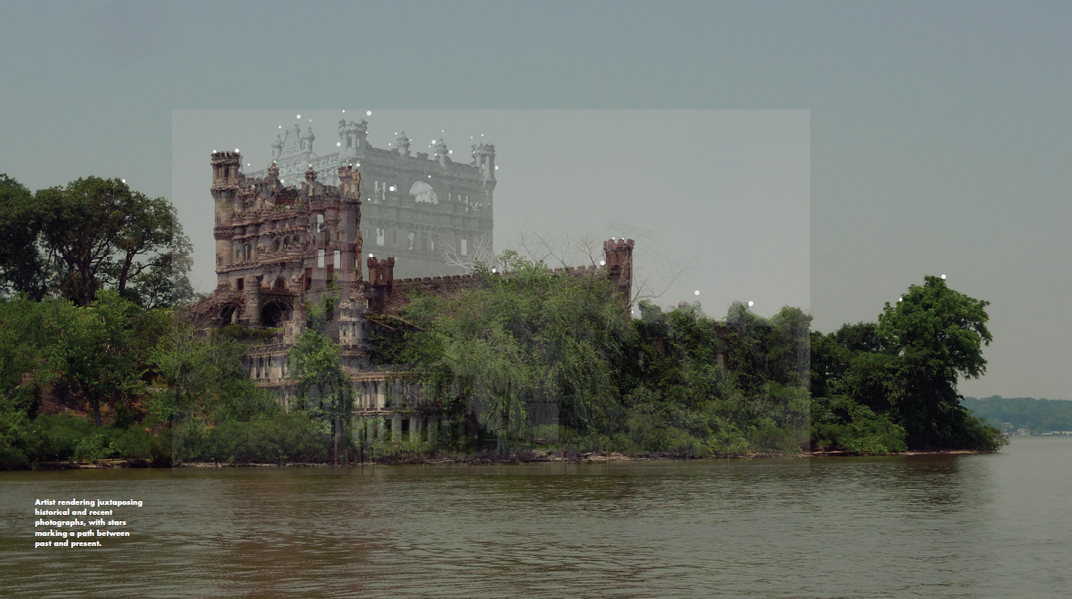An Abandoned Island Now Glows Star-Bright Under a New Constellation
Artist Melissa McGill creates a luminous public art project above a ruined castle on a mysterious piece of land in the Hudson River
/https://tf-cmsv2-smithsonianmag-media.s3.amazonaws.com/filer/31/17/3117d905-f7bc-4a9f-8834-731e229d2b46/bannerman_constellation_feb20_2015.jpg)
It used to be darker here. Starting this weekend, 17 new stars will illuminate Pollepel Island each night. Pollepel, about 60 miles north of Manhattan in the Hudson River, and also called Bannerman’s Island, is about 20,000 years old and known today for the abandoned castle rising up from its ancient rock. This summer, new stars will light up the island one by one at sunset, drawing those nearby to look anew at the old, mysterious land and its decaying estate.
The stars come not from the Milky Way but from Melissa McGill, an artist who lives near the island in Beacon, New York, and who is about to unveiled her latest installation. The piece, called Constellation, is a celestial scene with solar-powered LEDs inside hand-blown glass globes. Slender poles between 40 and 80 feet long keep the artist-born stars in the sky. For the next two years, they’ll glow for two hours every evening, fading out one by one, the same way they turn on.
McGill’s work is inspired in part by the island’s strange history. During research with collaborator Sam Anderson, McGill found that the land links the histories of the Lenape indigenous tribe, bootleggers and “an eccentric arms dealer,” among others. Although McGill says she’s heard people connect the abandoned castle to an alleged 18th-century king, the castle is in fact from the arms dealer, Francis Bannerman, who built it at the turn of the 20th century and “stuffed it full of armor and cannons and gunpowder.” In 1920, the powder house exploded—and then, nearly 50 years later, “a fire with flames 200 feet high devoured Bannerman’s warehouses, lighting up the Hudson Valley, leaving only the walls we see today.”

McGill also worked with the Lenape Center, whose co-director Hadrien Coumans calls this “one of the first projects in the area to honor and celebrate the indigenous perspective.” When McGill showed Coumans her rendering of the large installation, he said to her, “This is Opi Temakan,” explaining that the constellation is reminiscent of the “White Road” or “Milky Way,” which in Lenape culture connects our world with the next.
Despite all of the connections McGill has made between different peoples and eras, she often confronted how little historians know about the place, and much of what she’s dug up are just small glimpses of the past. That’s okay with her—partly because of experiences from her own history.
“I lived in Italy for a couple of years,” she says. “I’m sure my attraction to ruins is partly from that time.”
In places like Rome, she says, ancient ruins become part of the everyday modern landscape. While McGill does want to “invoke the long evolution that has led to the ruin we see today,” she also wants to take it as it is: an incomplete fragment. “It’s not so much the castle itself but what was missing from it that drew me to it,” she says.
But why 17 stars? “I took an original photograph of the site where the structure was complete,” McGill explains, “and then I took one of my photographs that I had taken from the river, from the shore.” She superimposed the pictures, one over the other, to see what was missing. The stars adorn the edges of the castle where it stands today, and also where it used to stand in the past. “It’s like a ghost image,” she says of the way the superimposed pictures show what is gone.
McGill also chose other star locations based on her exploration of the Lenape connection with Coumans. After she learned of Opi Temakan, for instance, she created several stars that point farther up—toward the sky and beyond. From no one spot, however, can a viewer see all of the stars in the project. Even McGill herself won’t know exactly how the constellation will look in three dimensions and from different vantage points until she sees the finished product when it launches on June 28.
Those who want to view the work alongside McGill can go on one of several artist-led boat tours. (Current dates are July 25, August 29 and September 26.) There will also be plenty of other boat tours, plus kayak tours, without McGill present. And, McGill says, the boat tours offer a unique opportunity to get close to the castle, which is normally off-limits. Folks will also be able to view the installation by land, on both the east and west sides of the Hudson River (details here), as well as by train.
Planning Your Next Trip?
Explore great travel deals
Smithsonian magazine participates in affiliate link advertising programs. If you purchase an item through these links, we receive a commission.
/https://tf-cmsv2-smithsonianmag-media.s3.amazonaws.com/accounts/headshot/michele-lent-hirsch.jpg)
/https://tf-cmsv2-smithsonianmag-media.s3.amazonaws.com/accounts/headshot/michele-lent-hirsch.jpg)